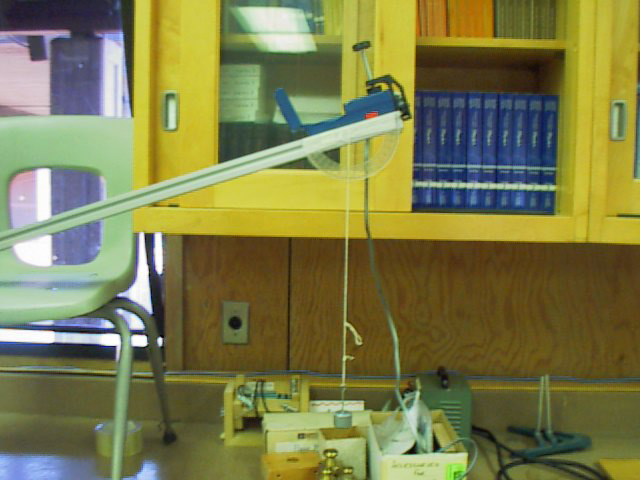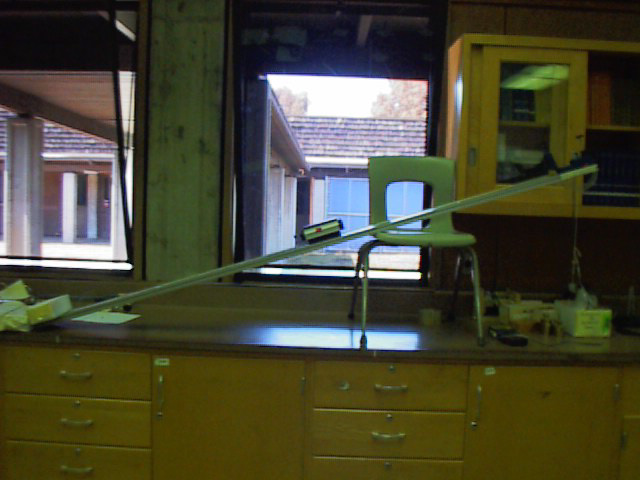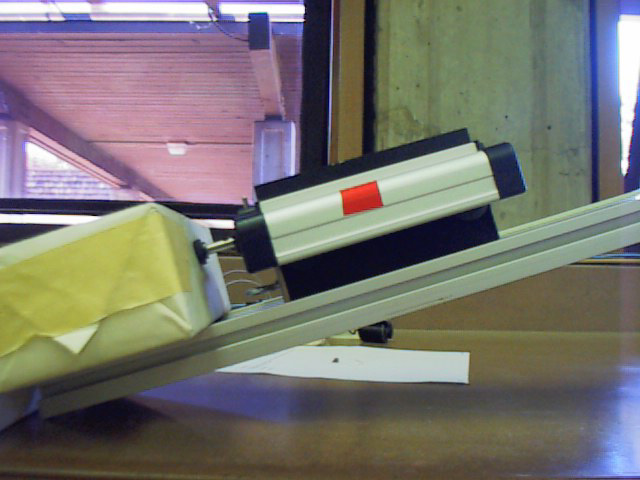Rockslide:
(A catchy name for a
slippery lab)
Introduction
If you were hiking in the mountains one day (as I often do) and you found yourself in the unhappy position of being at the
bottom of a hill (which had a constant slope) where the rocks were starting to fall, you would want to know the answers to
some rather relevant questions:
1) Now that the rocks are sliding down the hill, are they going to accelerate, maintain a constant velocity, or decelerate
and come to a wonderful stop?
2) Does the slope of the hill have any effect on the velocity of the rockslide? If so, what?
3) Does the mass of the rocks have any effect on the velocity of therockslide? If so, what?
4) Is there a God and do we have time to talk?
Objectives
Find the answers to the above questions (except for #4, that's on your own time) by setting up a situation in which we
cans study an object sliding down a slope and vary the two factors we are interested in: the angle of the slope and the
mass of the object.
 CBL & GC: Technology teaming up. A better use of batteries.
CBL & GC: Technology teaming up. A better use of batteries.
Equipment
• 1 to 2 meters of flat simulated mountainside (a dynamics cart track works well)
• Protractor with plumb bob to measure slope of track
• Chair or other support for track at different angles
• CBL
• TI-83 Plus Graphing Calculator with Vernier Physics Program
• Dymamics cart
• Friction block
• 2 500 g weights
 See the crude device used to measure the slope of the mountainside? It is called
a protractor and a plumb bob. Don't forget to attach the motion detector!
See the crude device used to measure the slope of the mountainside? It is called
a protractor and a plumb bob. Don't forget to attach the motion detector!
Procedure
First, make some predictions:
1) How does changing the slope (but keeping the mass constant) affect the velocity and acceleration of a sliding object?
2) How does changing the mass (but keeping the slope constant) affect the velocity and acceleration of a sliding object?
Fill in the table below by taking setting up your slope at the various angles indicated and running the time graph
program from the Physics Vernier application on the TI-83 Plus. Set up the Motion Detector by clamping it to the top of
the track. Don't forget to plug it into the CBL, which gets plugged into the Graphing Calculator. Start with the mass of
the friction block, and then add the cart, then 500 g, and then 500 more g. Do this for each angle indicated. After each
run, you will need to find the average velocity and the acceleration, and record it in the table.Your setup will look
something like the pictures below:
 The big picture: See the rocks sliding down the hill at the unsuspecting victims below.
The big picture: See the rocks sliding down the hill at the unsuspecting victims below.
 Ouch. This is where the rocks hit their target.
Ouch. This is where the rocks hit their target.
Observations/Data
|
Run #
|
Angle of elevation (degrees)
|
Mass (kg)
|
Average Velocity (m/s)
|
Acceleration (m/s/s)
|
|
1
|
16
|
|
|
|
|
2
|
16
|
|
|
|
|
3
|
16
|
|
|
|
|
4
|
16
|
|
|
|
|
5
|
18
|
|
|
|
|
6
|
18
|
|
|
|
|
7
|
18
|
|
|
|
|
8
|
18
|
|
|
|
|
9
|
20
|
|
|
|
|
10
|
20
|
|
|
|
|
11
|
20
|
|
|
|
|
12
|
20
|
|
|
|
|
13
|
22
|
|
|
|
|
14
|
22
|
|
|
|
|
15
|
22
|
|
|
|
|
16
|
22
|
|
|
|
To find the average velocity and acceleration for each run, you will need to analyze the graphs in the TI-83 Plus.
Conclusions/Extensions
1) Revisit the introductory questions and the predictions you made in the beginning. Answer the questions,
supported by your data. What happened, and why? What would folks like Galileo and Newton have to say about it all?
2) Dumb, but insightful questions: What would be the condition of the rockslide on a mountain slope of 0°? On a mountain
slope of 10°? On a mountain slope of 90°? If you increas the mass of the rocks on these mountain slopes, would it
change their velocities or acclerations? What does this tell you about this particular problem?
3) Answer this question, and relate it to the results of this lab:
A large truck travelling down a hill at 50 mph hits the brakes, starts skidding and takes 100 meters to come to
a complete stop. How far will he skid before he comes to a complete stop on the same stretch of highway if we
double the mass of his truck?
Notes for the Instructor
Well, if I had more time, I'd write some good notes...but I don't...so, maybe later if I have more time. Right now,
I need to go for a nice long hike in the mountains. Watch out for falling rocks! :-)
 CBL & GC: Technology teaming up. A better use of batteries.
CBL & GC: Technology teaming up. A better use of batteries.CBL & GC: Technology teaming up. A better use of batteries.
See the crude device used to measure the slope of the mountainside? It is called a protractor and a plumb bob. Don't forget to attach the motion detector!
The big picture: See the rocks sliding down the hill at the unsuspecting victims below.
Ouch. This is where the rocks hit their target.